
STAND-IN: In January 2020, the U.S. Army tested Advanced Running Gear on existing Bradley vehicles for potential use on the future Optionally Manned Fighting Vehicle at Yuma Proving Ground, Arizona. (Photo by Mark Schauer, Yuma Proving Ground)
Behavioral biases have played a significant role in acquisition program decision-making, specifically hampering the Army’s efforts to modernize and upgrade infantry combat vehicles.
by Robert F. Mortlock, Ph.D., Col., USA (Ret.)
This is the second in a series of articles focused on behavioral acquisition—a topic first introduced in the Fall 2021 Army AL&T magazine.
Behavioral acquisition explores defense acquisition from a behavioral standpoint, including the impact of psychology, organizational behavior and organizational politics on decision-making in acquisition programs that ultimately affect the delivery of capability to the warfighter. Behavioral acquisition studies how acquisition professionals think, manage and lead acquisition programs—and addresses organizations, hierarchies and the intersection of individual behavior, leadership, culture and decision-making.
One aspect in particular, behavioral biases, is the focus of this article. These biases have a common root in people’s limited ability to process large amounts of information, resulting in poor decision-making. That, in turn, contributes to acquisition program failures. A case study is the Army’s efforts to modernize its infantry combat fighting vehicles. The decadeslong effort has shown evidence of multiple decision-making biases: planning fallacy bias, overoptimism bias, recency bias and trade-off bias.
A HISTORY OF DECISIONS
The Bradley Fighting Vehicle remains the backbone of Army mechanized infantry warfighter formations. Developed in the 1960s, the Bradley (see Figure 1) was initially fielded in the early 1970s and has been upgraded several times to offer Soldiers enhanced capabilities. Since the early 2000s, the Army has been trying to replace the Bradley because size, weight and power constraints severely restrict potential upgrade options. After an 11-year development effort, the Bradley has been in production for 50 years.
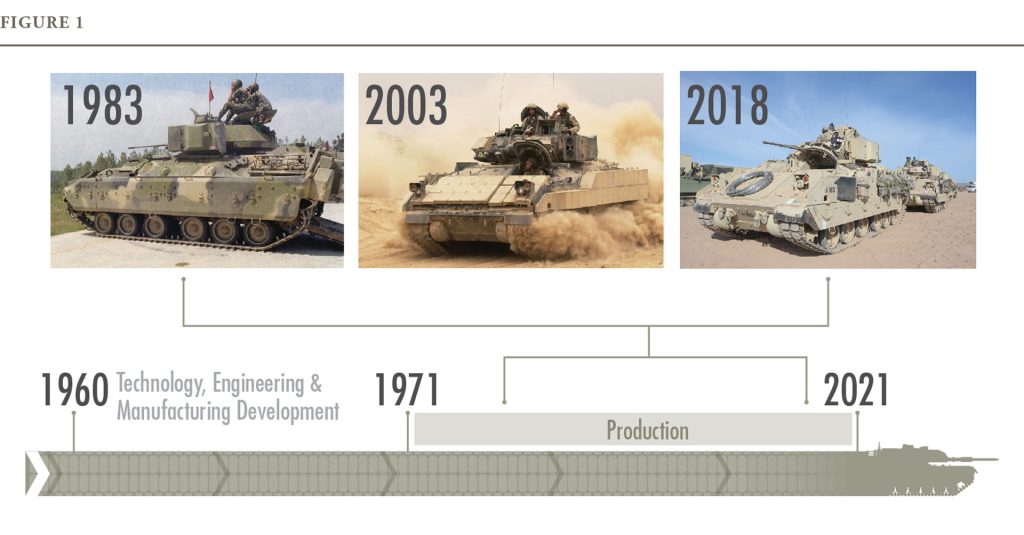
EVOLUTION OF THE BRADLEY: After an 11-year development effort, the Bradley Fighting Vehicle has been in production for 50 years. (Graphic by USAASC adapted from “Then and now: Next generation on track,” Army AL&T magazine, Spring 2019.)
One attempt at a Bradley replacement was the Infantry Carrier Vehicle (ICV), part of a family of manned ground vehicles within the planned Future Combat Systems program. (See Figure 2) Future Combat Systems entered the acquisition framework as an official program of record at milestone B to begin engineering and manufacturing development (EMD) efforts in 2003 with a planned milestone C (low-rate initial production) in 2009, later shifted to 2013. The 10-year time frame for technology development, design, prototyping and engineering and manufacturing development was similar to the Bradley program and other efforts of similar complexity and risk. However, the Infantry Carrier Vehicle effort (along with the entire Future Combat Systems program) was canceled in 2009.
Defense acquisition experts have referenced Future Combat Systems as an example of everything wrong with defense acquisition—a canceled program that wasted billions of dollars and delivered no capability to warfighters. A 374-page 2012 RAND Corp. report, “Lessons From the Army’s Future Combat Systems Program,” highlighted hundreds of lessons from different aspects of the program, including requirements management, program management, contracting and technology management.
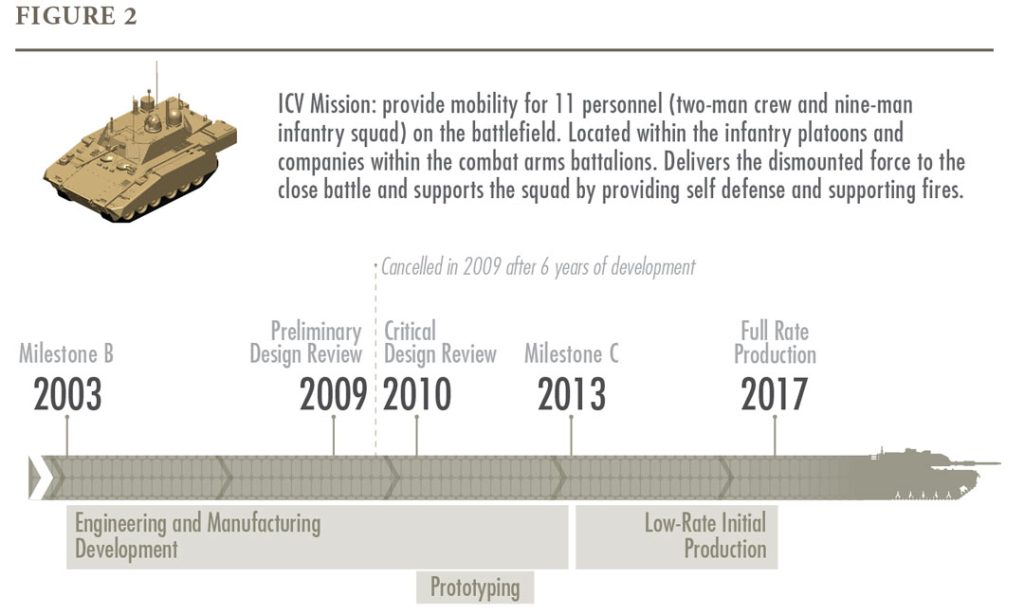
INFANTRY CARRIER VEHICLE: One attempt at a Bradley replacement was the Infantry Carrier Vehicle (ICV). It was part of the ill-fated Future Combat Systems program and canceled in 2009. (Graphic by USAASC)
The Future Combat Systems program attempted to integrate critical technologies using a system-of-systems management approach. The program started as a Defense Advanced Research Projects Agency effort contracted through other-transaction authority (OTA) with Boeing and its industry partners. The OTA incentivized Boeing to get the Army to an approved milestone B and establish a baseline for the formal program of record as quickly as possible.
Boeing and the Army achieved a successful milestone B in 2003. The OTA also enabled Boeing to become the lead system integrator for the Future Combat Systems program. Despite warnings from the Government Accountability Office (GAO) in a 2004 report titled “Defense Acquisitions: The Army’s Future Combat Systems’ Features, Risks, and Alternatives,” which warned of immature technologies and lack of adequate funding, the Army marched forward. The Future Combat Systems program was canceled in 2009 primarily for being unaffordable, overly ambitious from a technology maturity standpoint (integration of too many critical technologies with low maturity), overly complex from a program management standpoint (the system-of-systems approach), and for failing to reflect current emerging threat requirements from conflicts in Iraq and Afghanistan.
Future Combat Systems can be studied with a behavioral acquisition lens. The Army did not appreciate the effects of the planning fallacy bias, and the result was a gap between plans and outcomes. The Army built an unrealistic “insider view” of a program, with detailed plans for implementation, to gain program-of-record approval. These detailed plans enhanced the Army’s perception of control over the program and confidence in its success that were unwarranted when the full context of the program was considered.
The effects of the planning fallacy are not unique to the Infantry Carrier Vehicle effort within Future Combat Systems or to Army acquisition programs in general. A 2015 GAO report titled “Defense Acquisitions: Joint Action Needed by DOD and Congress to Improve Outcomes,” highlighted that program managers (PMs) are incentivized to develop acquisition strategies focused on program approval at the milestone review but not acquisition strategies that could later be executed and deliver capabilities.
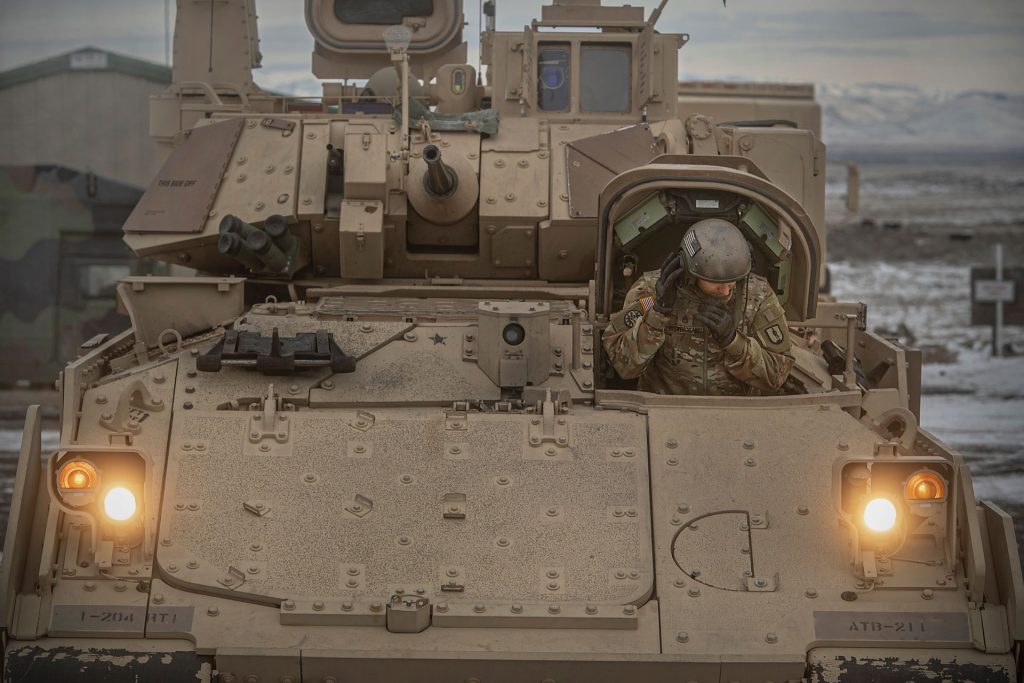
MOVING OUT: Idaho Army National Guard Staff Sgt. Daniel Bistriceanu checks his communications equipment before moving out to fuel up a Bradley Fighting Vehicle. The Army has been trying to replace the Bradley since the early 2000s because of its size, weight and power constraints. (Photo by Thomas Alvarez, Idaho Army National Guard)
It is ironic that the planning fallacy has roots in what are perceived to be good management practices. Program planning efforts tend to reinforce idealized perceptions of control, resulting in PMs typically thinking they have more control over outcomes than they have in reality. The planning fallacy creates biased expectations that will impact the cost, schedule and performance baseline over the course of most programs.
Future Combat Systems was also hampered by overoptimism bias—the tendency to see the world through “rose-colored glasses” or expect positive outcomes even when not justified. The Army’s “can do” mentality, combined with the general observation that the program management field generally rewards optimistic individuals, led to a Future Combat Systems Infantry Carrier Vehicle program plan that was overly optimistic. In this case, the Army underestimated the technical maturity level of the critical technologies, the complexity of the development effort and the difficulty in transforming the way the mechanized infantry fights (concept of operations as well as tactics, techniques and procedures).
Recency bias is the widely recognized bias wherein recent data are given disproportionate emphasis in making judgments. Recency bias occurs when individuals process large amounts of information and rely on intuition. This helps them sort through the information but also introduces biases and leads to suboptimal decisions.
Future Combat Systems was plagued with recency bias from its inception—specifically from the tendency to incorporate as many of the latest acquisition reform initiatives as possible.
The program was initiated by leveraging a Defense Advanced Projects Research Agency effort. Future Combat Systems chose the innovative, non-Federal Acquisition Regulation (FAR)-based contracting approach with the use of an OTA. Finally, the program incorporated the use of a contractor to act as the lead system integrator as well as a system-of-systems approach (rather than separate programs).
The use of any one of these recent acquisition reform initiatives would have been a significant shift in acquisition management, but the Army felt obligated to incorporate multiple initiatives, despite the availability of more appropriate, less risky acquisition management approaches like a longer incremental development.
Finally, Future Combat Systems was saddled with a difficulty in making trade-offs. The trade-off bias is central to program management, particularly trade-offs among program cost, schedule and performance that form the acquisition program baseline.
Decision theory has proposed rational methodologies for making trade-offs by confronting them systematically, typically through some version of cost-benefit analysis. But the models based on rationality bump up against the realities of the complex defense acquisition environment.
Typically, rational, reason-based models make conflicting choices easier to evaluate. By constructing reasons, individuals turn difficult-to-reconcile characteristics of options into a problem that is more comprehensible.
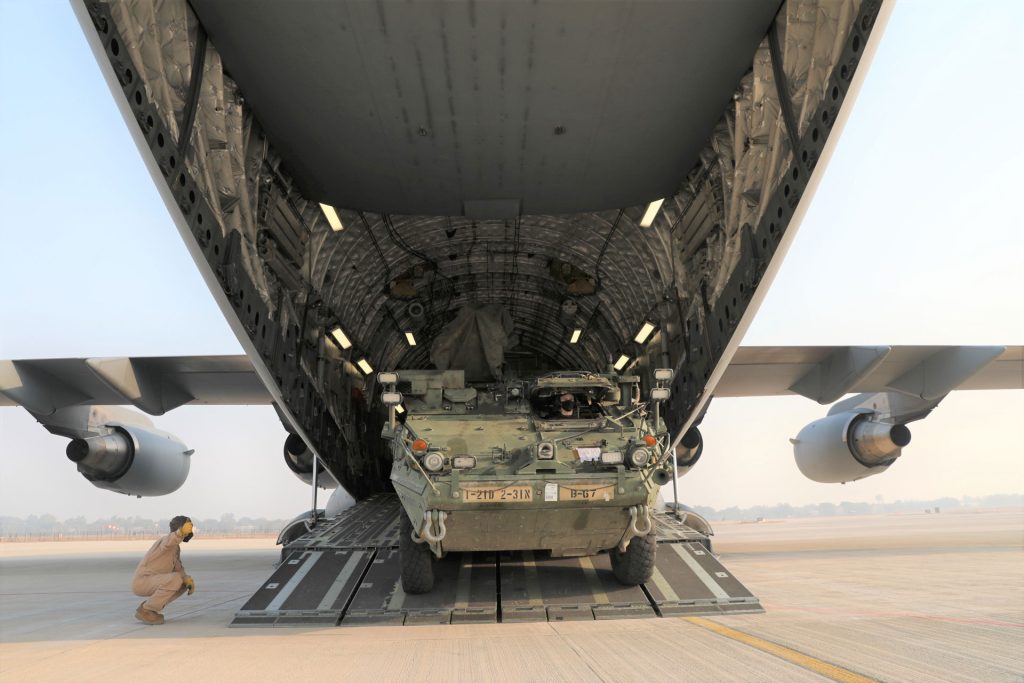
ROLLING ALONG: A U.S. Army Stryker infantry carrier vehicle rolls off a C-17 cargo plane in India Feb. 1, 2021. (Photo by Staff Sgt. Joseph Tolliver, 1-2 Stryker Brigade Combat Team)
Furthermore, it is likely that reason-based choice may be even more difficult when groups are making decisions, reflecting the fact that programs involve numerous stakeholders and significant resources, and that decisions have to be justified and approved by oversight groups.
Therefore, while individuals typically choose using rational models, groups may prefer reasons based on social, organizational or political dynamics.
The Future Combat Systems operational requirements document approved by the Army Requirements Oversight Council and the Joint Requirements Oversight Council was 475 pages long and contained hundreds of key performance parameters, key system attributes, and additional performance attributes, leading to thousands of design specifications for the Infantry Carrier Vehicle. The vehicle simply had too many requirements placed on it, making the trade-offs of performance, cost and schedule beyond the cognitive capability of individual PMs and Army leaders and too difficult for the Army from an organizational perspective. Basically, all the requirements were treated as important—too difficult to trade off.
After cancellation of Future Combat Systems in 2009, the Army embarked on the Ground Combat Vehicle (GCV) program (see Figure 3) to replace the Bradley. All resources that had been supporting the oversight and management of the development of a family of FCS-manned ground vehicles (including the Infantry Carrier Vehicle) were now applied to the development of the Ground Combat Vehicle. This program achieved a materiel-development decision in 2010 and milestone A in 2011 to award technical maturation and risk reduction contracts to industry.
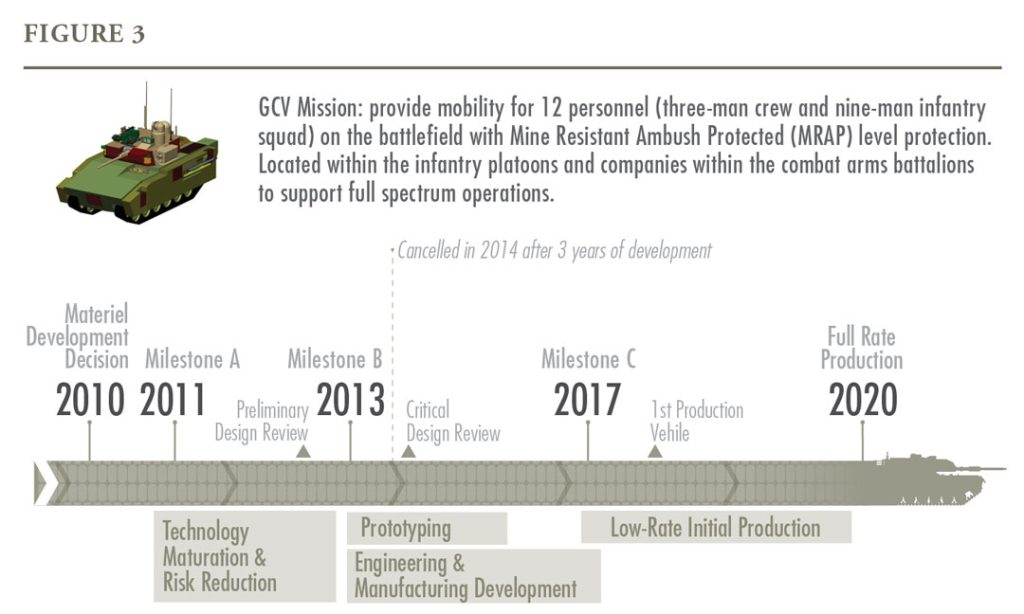
GROUND COMBAT VEHICLE: Ground Combat Vehicle (GCV) also attempted to replace the Bradley. In 2014, the Army canceled the program because the vehicle was going to be too big and heavy and had too many requirements. (Graphic by USAASC)
The same two industry partners that were teamed together in the Future Combat Systems Infantry Carrier Vehicle program now competed against each other in a technical maturation and risk reduction phase for the Ground Combat Vehicle. The program had an aggressive schedule to get to milestone C within six years of milestone A—influenced by planning fallacy and overoptimism bias like the Infantry Carrier Vehicle program. The Army began the Ground Combat Vehicle program and awarded firm fixed price-type research and development contracts to BAE Systems and General Dynamics for designs and prototypes. The new vehicle’s requirements called for a heavy reliance on mature commercial technologies. In an example of recency bias, Better Buying Power initiatives strongly encouraged the use of firm fixed-price research and development contracts despite the lack of appropriateness based on the level of system integration complexity and risk.
The Ground Combat Vehicle requirements included a mixture from the Bradley, the Future Combat Systems Infantry Carrier Vehicle, the recently fielded Mine Resistant Ambush Protected vehicles, and the M1A2 Abrams tank. Based on the GCV requirements, the program office, industry competitors and the research, development and engineering center at the U.S. Army Tank-automotive and Armaments Command (TACOM) determined that the GCV would weigh between 50 and 70 tons—nearing the weight of the 72-ton M1A2 Abrams tank and almost twice as heavy as the Bradley or the planned 30-ton Infantry Carrier Vehicle. The GCV had force protection, survivability and lethality requirements for a mechanized infantry vehicle that more resembled an armored tank.
In subsequent reviews with Army senior leaders, the potential weight of the Ground Combat Vehicle and excessive requirements were highlighted. However, the Army pushed ahead and approved the requirements—heavily affected by a difficulty in making trade-offs. The technical maturation and risk reduction contracts seemed to be based primarily on a need to protect the planned and programmed resources from the old Future Combat Systems Manned Ground Vehicles program (schedule-driven). In 2014, three years into the development effort, the Army canceled the Ground Combat Vehicle program because the vehicle was going to be too big and heavy and had an excessive number of requirements.
In recent years, after several failed attempts of initiating the Next Generation Combat Vehicle because of aggressive requirements and a lack of interest by industry, the Army is trying again—this time calling the Bradley replacement the Optionally Manned Fighting Vehicle.
The Optionally Manned Fighting Vehicle program plan is presented in Figure 4. The program is leveraging the newly established middle tier of acquisition pathway and begins not with a milestone A or B, but with an acquisition decision memorandum from the milestone decision authority. After the prototyping phase, a materiel-development decision will continue the design effort and start build and integration efforts. The program plan specifically avoids using the technical maturation and risk reduction and engineering and manufacturing development phases of a major-capability acquisition. Again, as with the Ground Combat Vehicle program schedule, the Army plans to achieve the milestone C within seven years of program initiation. Interestingly, the program uses the terms “characteristics of need” to describe the requirements to competing contractors rather than more traditional terms like key performance parameters.

OPTIONALLY MANNED FIGHTING VEHICLE: The Optionally Manned Fighting Vehicle (OMFV) program leverages the newly established middle tier of acquisition but is susceptible to the same behavior acquisition biases that contributed to the failures of the predecessor Bradley replacement vehicles. (Graphic by USAASC)
The Optionally Manned Fighting Vehicle program is susceptible to the same behavior acquisition biases (planning fallacy, overoptimism bias, recency bias, and difficulty in making trade-offs) as contributed to the failures of the predecessor Bradley-replacement acquisition efforts. How can the design and development of a mechanized infantry vehicle be optimized for troop transport and protection, lethality and remote autonomous operations simultaneously? Unfortunately, the answer is that it can’t—this will require difficult requirement trade-offs to avoid the planning fallacy and overoptimism bias. A vehicle that is optimized to protect the crew and dismounted troops being transported would be an inefficient combat vehicle for lethal autonomous operations (too big and heavy).
It appears that recency bias has also played a significant role in the Optionally Manned Fighting Vehicle program planning. Is the Army more interested in riding the autonomous vehicle hype wave? Or does the Army have other priorities like proving that major-capability acquisition can be done differently or innovatively in the newly established Army Futures Command?
The Optionally Manned Fighting Vehicle acquisition strategy leverages the middle-tier of acquisition pathway to avoid forming a program of record to enter the engineering and manufacturing development phase after a successful milestone B. The Optionally Manned Fighting Vehicle program will use middle-tier authorities to rapidly prototype vehicles for experimentation and demonstration and then establish a formal acquisition program of record at milestone C to enter low-rate initial production. For requirements, the Army initiated the Optionally Manned Fighting Vehicle program with a general characteristics of need document to avoid the approval of an initial capability document.
The exact opposite strategy has been recommended by the GAO for more than three decades for major defense acquisition programs—knowledge-based acquisition strategies with incremental development. Defense acquisition programs have routinely rushed to production decisions without well-defined requirements, complete detailed design drawings, fully mature technologies and mature manufacturing processes, and without demonstrating production-representative systems in an operationally relevant environment. The Optionally Manned Fighting Vehicle program is attempting to do in a middle tier of acquisition rapid prototyping effort what a major defense acquisition program achieves in a formal engineering and manufacturing development effort—a classic “schedule-driven” rush to failure with suboptimal decision-making that appears to be dominated by biases similar to those biases that plagued previous attempts to replace and modernize the infantry combat vehicles.
CONCLUSION
The behavioral biases of planning fallacy, overoptimism, recency and trade-offs difficulty have contributed to repeated failures in the Army infantry combat vehicle acquisition programs. Figure 5 summarizes the behavioral biases observed in the Future Combat Systems Infantry Carrying Vehicle, the Ground Combat Vehicle and the Optionally Manned Fighting Vehicle programs. Acquisition management has been highlighted on the GAO’s high-risk list for excessive waste and mismanagement for the past three decades. Notable programs have failed to deliver capability and have failed to meet performance, cost and schedule management targets. The reasons for program failure vary from ill-defined requirements, immature technologies, integration challenges, poor cost and schedule estimating, and the acceptance of too much development risk.

BEHAVIORAL BIASES: Programs can fail for many reasons—ill-defined requirements, immature technologies, integration challenges, poor cost and schedule estimating, and the acceptance of too much risk. (Graphic by USAASC)
But the effect that the behavioral biases have in poor decision-making may be an even bigger contributor to acquisition program failures—the true root causes. The better acquisition professionals understand the effect of these systemic behavioral biases, the better DOD can mitigate the risks of program failures. The key is a better understanding of the people within big “A” defense acquisition.
ROBERT F. MORTLOCK, Ph.D., Col., USA (Ret.) managed defense systems development and acquisition efforts for the last 15 of his 27 years in the U.S. Army. He is now a professor of the practice and principal investigator of the Acquisition Research Program, teaching defense acquisition sciences and program management at the Naval Postgraduate School. He holds a Ph.D. in chemical engineering from the University of California, Berkeley, an MBA from Webster University, an M.S. in national resource strategy from the Industrial College of the Armed Forces, and a B.S. in chemical engineering from Lehigh University. He holds Level III certifications in program management, test and evaluation, and engineering, as well as the Professional Engineering, Project Management Professional and Program Management Professional credentials. His most recent column for Army AL&T appeared in the Summer 2021 issue.







